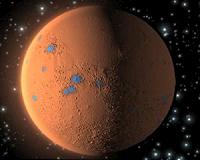 |
Bonn, Germany (SPX) Dec 13, 2010 The small crater embedded in the north-western rim of the Schiaparelli impact basin features prominently in this new image acquired by the High-Resolution Stereo Camera (HRSC) operated by the German Aerospace Center (Deutsches Zentrum fur Luft- und Raumfahrt; DLR) on ESA's Mars Express spacecraft. The image was acquired on 15 July 2010. All around is evidence of water in the past and the strong Martian winds that blow periodically. Schiaparelli is a large impact basin about 460 kilometres in diameter located in the eastern Terra Meridiani region on the equator of Mars. The centre of the basin lies at about 3 degrees S/17 degrees E and it is named after the Italian astronomer Giovanni Schiaparelli (1835-1910). Although he also studied Mercury and Venus, he is best known for his observations of the Red Planet. During the 'Great Opposition' of 1877, when Mars passed close to Earth, Schiaparelli mapped the planet, discovering a number of straight dark lines across the red surface. He assumed that these were natural, water-filled channels and used the equivalent Italian word, 'canali'. However, other astronomers thought he meant canals - artificial irrigation and transportation routes - which led to a few astronomers, and a large number of members of the general public, believing that they had been created by intelligent Martians. However, we now know that Schiaparelli's 'canali' were illusions created by the comparatively poor telescopes of the time and there are no water-filled channels on Mars today. Nevertheless, there is evidence in this new image that water was once present in this region of the planet, perhaps in the form of a lake. The scene shows a small part of the north-western area of the Schiaparelli basin with the crater rim, the crater interior and parts of the surrounding highlands. Evidence for water can be seen in the form of dark sediments that appear on the floor of Schiaparelli, resembling those deposited by evaporated lakes on Earth. The interior of Schiaparelli has been modified by multiple geological processes, including the fall of ejecta blasted upwards by the initial impact, flows of lava that created the smooth plains and deposition of watery sediments. The High-Resolution Stereo Camera, HRSC, on the European Space Agency's Mars Express mission is led by the Principal Investigator (PI) Prof. Dr Gerhard Neukum, who was also responsible for the technical design of the camera. The science team of the experiment consists of 45 co-investigators from 32 institutions and 10 nations. The camera was developed at the German Aerospace Center, DLR, under the leadership of the PI and it was built in cooperation with industrial partners EADS Astrium, Lewicki Microelectronic GmbH and Jena-Optronik GmbH. The instrument on Mars Express is operated by the DLR Institute of Planetary Research, through ESA/ESOC. The systematic processing of the HRSC image data is carried out at DLR. The scenes shown here were processed by the PI-group at the Institute for Geosciences of the Freie Universitat Berlin in cooperation with the DLR Institute of Planetary Research, Berlin.
Share This Article With Planet Earth
Related Links ESA Mars Express Mars News and Information at MarsDaily.com Lunar Dreams and more
 Shallow Groundwater Reservoirs May Have Been Common On Mars
Shallow Groundwater Reservoirs May Have Been Common On MarsTucson AZ (SPX) Nov 23, 2010 An international research team led by the Planetary Science Institute has found evidence for reservoirs of liquid water on Mars at shallow crustal depths of as little as tens of meters. J. Alexis Palmero Rodriguez, research scientist at PSI, and the research team came to this conclusion after studying collapsed terrains that occur within some of the solar system's largest channels. I ... read more |
|
| The content herein, unless otherwise known to be public domain, are Copyright 1995-2010 - SpaceDaily. AFP and UPI Wire Stories are copyright Agence France-Presse and United Press International. ESA Portal Reports are copyright European Space Agency. All NASA sourced material is public domain. Additional copyrights may apply in whole or part to other bona fide parties. Advertising does not imply endorsement,agreement or approval of any opinions, statements or information provided by SpaceDaily on any Web page published or hosted by SpaceDaily. Privacy Statement |